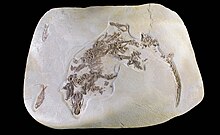Cimolesta
| Cimolesta Temporal range: Late Cretaceous - Eocene
| |
|---|---|

| |
| Palaeospinopa from Wyoming Eocene | |
| Scientific classification | |
| Domain: | Eukaryota |
| Kingdom: | Animalia |
| Phylum: | Chordata |
| Class: | Mammalia |
| Clade: | Eutheria |
| Order: | †Cimolesta McKenna 1975 |
| Subgroups | |
Cimolesta is an extinct order of non-placental eutherian mammals.[1] Cimolestans had a wide variety of body shapes, dentition and lifestyles, though the majority of them were small to medium-sized general mammals that bore superficial resemblances to rodents, weasels or opossums.
Several groups have previously been suggested to have descended from the Cimolesta: the Pholidota (which would have been regarded as a suborder of Cimolesta), the Creodonta, and the Carnivora. The origins of the enigmatic Dinocerata have been suggested to lie within the Cimolesta as well. However, recent studies have revealed that cimolestans are more likely to be basal, non-placental eutherians, with no living descendants.[1]
Some experts had placed the pangolins within Cimolesta, though the current consensus is that the pangolins should be placed within their own order, Pholidota, as a sister taxon to Carnivora within Ferae.[2][3] Some have also placed the enigmatic family Ptolemaiidae within Cimolesta, also due to similarities between dental and skull anatomies with those of Pantolesta. If the ptolemaiids were indeed cimolestids, then Cimolesta would have ranged from the Late Cretaceous to the early Miocene, when the last ptolemaiid, Kelba, disappeared in Eastern Africa. However, more thorough studies suggest that the ptolemaiids were more probably afrotheres related to aardvarks, tenrecs and golden moles.[4] [5] If one ignores the ptolemaiids as afrotherians, then the last, unequivocal cimolestids, the pantolestids Gobiopithecus and Kiinkerishella, died out during the Late Eocene or early Oligocene.
The cimolestid, Procerberus, may have been closely related to Taeniodonta.[6][7][8][9][10] Procerberus was the largest cimolestid and different species may be closer to conoryctid taeniodonts and others to stylinodontine taeniodonts. However, Procerberus has been found by cladistic analysis to be outside of a Taeniodonta + Alveugena carbonensis, with Procerberus grandis being closer to that clade than to other Procerberus species.[7]
References
- ^ a b Rook, D.L.; Hunter, J.P. (2013). "Rooting Around the Eutherian Family Tree: the Origin and Relations of the Taeniodonta". Journal of Mammalian Evolution. 21: 1–17. doi:10.1007/s10914-013-9230-9.
- ^ Murphy, Willian J.; O'Brien, SJ; et al. (2001-12-14). "Resolution of the Early Placental Mammal Radiation Using Bayesian Phylogenetics". Science. 294 (5550): 2348–2351. Bibcode:2001Sci...294.2348M. doi:10.1126/science.1067179. PMID 11743200.
- ^ Beck, Robin MD; Bininda-Emonds, Olaf RP; Cardillo, Marcel; Liu, Fu-Guo; Purvis, Andy (2006). "A higher-level MRP supertree of placental mammals". BMC Evolutionary Biology. 6 (1): 93. doi:10.1186/1471-2148-6-93. PMC 1654192. PMID 17101039.
{{cite journal}}: CS1 maint: unflagged free DOI (link) - ^ Cote S, Werdelin L, Seiffert ER, Barry JC (March 2007). "Additional material of the enigmatic Early Miocene mammal Kelba and its relationship to the order Ptolemaiida". Proc Natl Acad Sci USA. 104 (13): 5510–5. Bibcode:2007PNAS..104.5510C. doi:10.1073/pnas.0700441104. PMC 1838468. PMID 17372202.
- ^ Seiffert, Erik R (2007). "A new estimate of afrotherian phylogeny based on simultaneous analysis of genomic, morphological, and fossil evidence". BMC Evolutionary Biology. 7 (1): 224. doi:10.1186/1471-2148-7-224. PMC 2248600. PMID 17999766.
{{cite journal}}: CS1 maint: unflagged free DOI (link) - ^ Clemens, W. A. (2017). Procerberus (Cimolestidae, Mammalia) from the Latest Cretaceous and Earliest Paleocene of the Northern Western Interior, USA. PaleoBios, 34, 1-26. https://escholarship.org/uc/item/1dv645n5
- ^ a b Eberle, J. J. (1999). Bridging the transition between didelphodonts and taeniodonts. Journal of Paleontology, 73, 936-944.
- ^ Schoch, R. M. 1986. Systematics, functional morphology, and macroevolution of the extinct mammalian order Taeniodonta. Peabody Museum Bulletin, 42:1-307
- ^ LILLEGRAVEN, J. A. 1969. Latest Cretaceous mammals of upper part of Edmonton Formation of Alberta, and review of marsupial-placental dichotomy in mammalian evolution. The University of Kansas Paleontological Contributions, 50(Vertebrata 12), 122.
- ^ MIDDLETON, M. D. 1983. Early Paleocene vertebrates of the Denver Basin, Colorado. Unpublished Ph.D. dissertation, University of Colorado, Boulder, 404.
Sources
- McKenna, MC (1975). "Toward a phylogenetic classification of the Mammalia". In Luckett, WP; Szalay, FS (eds.). Phylogeny of the primates: a multidisciplinary approach (Proceedings of WennerGren Symposium no. 61, Burg Wartenstein, Austria, July 6–14, 1974. New York: Plenum. pp. 21–46. doi:10.1007/978-1-4684-2166-8_2. ISBN 978-1-4684-2168-2.
{{cite book}}: Invalid|ref=harv(help) - McKenna, M.C.; Bell, S.K. (1997). Classification of mammals above the species level. New York: Columbia University Press. ISBN 978-0-231-11013-6.
{{cite book}}: Invalid|ref=harv(help) - Rose, KD (2006). The beginning of the age of mammals. Baltimore: JHU Press. ISBN 978-0801884726.
{{cite book}}: Invalid|ref=harv(help) - Simons, EL; Bown, TM (April 11, 1995). "Ptolemaiida, a new order of Mammalia--with description of the cranium of Ptolemaia grangeri". PNAS. 92 (8): 3269–73. Bibcode:1995PNAS...92.3269S. doi:10.1073/pnas.92.8.3269. PMC 42147. PMID 11607526.
